Environmental subsidies and similar transfers statistics
Data extracted in April 2023
Planned article update: 27 May 2024
Highlights
In 2020, environmental transfers in the EU ranged from 0.3 % of GDP in Luxembourg to 1.2 % of GDP in Malta.
In 2020, corporations, general government and households were the main recipients of environmental transfers in the EU.
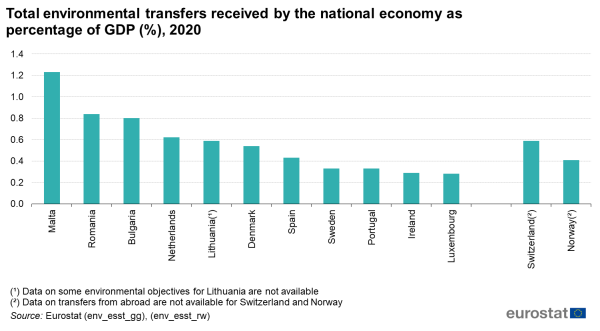
Source: Eurostat (env_esst_gg), (env_esst_rw)
This article reports on subsidies and other payments whenever the purpose is to protect the environment or manage natural resources (‘environmental transfers’), such as for installing cleaner energy or for keeping nature reserves, or for research on environmental issues. The public subsidies and other payments related to the environment in EU countries ranged between 0.3 % and 1.2 % of their GDP in 2020. This article includes financing received by corporations, households, or public authorities and paid by the public administrations of the country or from abroad (including EU funds).
Full article
National environmental transfers ranged between 1.2 % and 0.3 % of GDP in 2020
For the 13 countries reporting 2020 data to Eurostat, environmental transfers range from 1.2 % of GDP in Malta to 0.8 % in Romania and Bulgaria, down to 0.3 % in Sweden, Portugal, Ireland and Luxembourg (Figure 1). The estimates in this article come from a Eurostat voluntary data collection and data are only available for some countries.

Source: Eurostat (env_esst_gg), (env_esst_rw)
Environmental transfers increased between 2017 and 2019, but decreased in 2020
In 2019, environmental transfers as a percentage of GDP reached their maximum in Lithuania, Malta and Romania. Those countries presented a similar trend over recent years, with a continuous increase until 2019 and a decrease in 2020. Romania had the highest share of GDP over the period 2017 to 2019, increasing from 1.3 % to 2.9 % of GDP. However, in 2020, environmental transfers amounted to 0.8 % of GDP in Romania. In 2020, environmental transfers reached their maximum percentage in Spain, Luxembourg, the Netherlands, as well as in Norway and Switzerland, within a range of 0.3 % to 0.6 % of GDP. On the other hand, Bulgaria and Ireland recorded the highest percentage in 2018 (Figure 2) with, respectively, 0.9 % and 0.4 % of GDP.
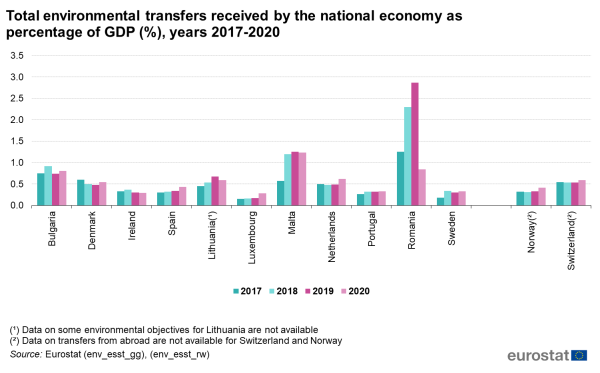
Source: Eurostat (env_esst_gg), (env_esst_rw)
Environmental transfers are mainly paid by general government
In Denmark, Ireland, Spain, Malta and Sweden, general government contributes to more than 80 % of the environmental transfers received in the country; the remaining share are incoming international flows (including EU funds). In Bulgaria, Lithuania, Portugal and Romania, the contribution by other countries and the EU is larger than the contribution by general government: from 80 % in Bulgaria to slightly more than 50 % in Portugal (Figure 3).
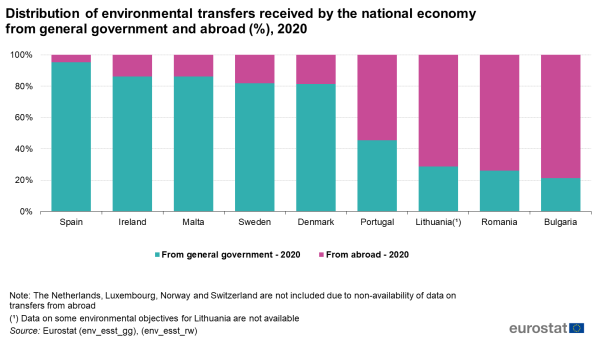
Source: Eurostat (env_esst_gg), (env_esst_rw)
In general, corporations, general government and households are the main recipients of the transfers paid by general government (Figure 4). In 2020, Spain was the country where corporations received the highest share of the environmental transfers (99%). Environmental transfers from general government to other sub-sectors of general government are largest for Romania (57 %), Malta (53 %), Bulgaria (47 %) and Ireland (47 %), while they are significant in the Netherlands (43 %), as well as in Switzerland (32 %). These environmental transfers usually occur when central government provide funds to regional authorities, which further distribute these funds to final beneficiaries, e.g. programmes for financing of energetic refurbishment works to improve energy efficiency in buildings. In 2020, Portuguese households received 84 % of the environmental transfers paid by general government. Households are also the main recipient of the transfers in Switzerland (58 %), the Netherlands (49 %) and Lithuania (47 %). These differences across countries reflect the different economic actors and policy instruments that national governments choose to use. Non-profit institutions serving households (NPISH) usually receive fewer environmental transfers than corporations and households. Environmental transfers received by NPISH in Norway and Portugal are respectively 14 % and 10 % of the environmental transfers paid by general government. On average for the reporting countries, environmental transfers received by NPISH are 2.6 % of the total environmental transfers paid by general government. Similarly, environmental transfers paid by the country governments to other countries are lower than environmental transfers to their national corporations and households. Environmental transfers sent to other countries represent 31 % of the total environmental transfers paid by general government in Norway and 17 % in Sweden. On average for countries reporting to Eurostat, 5 % of the total environmental transfers are sent to other countries.
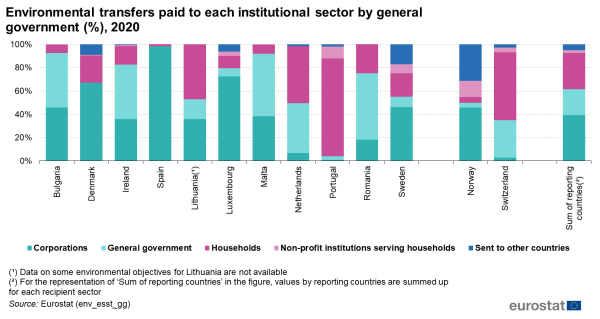
Source: Eurostat (env_esst_ggcp)
Four economic activities account for 84 % of environmental transfers paid to corporations
Environmental transfers to corporations can be further broken down by the economic activity of the corporation. Eurostat uses the statistical classification NACE Rev 2 (Figure 5). In 2020, ‘agriculture, forestry and fishing’ and ‘electricity, gas, steam and air conditioning supply’ were the economic activities receiving most environmental transfers from general government transfers in most countries. Corporations operating in ‘agriculture, forestry and fishing’ received 63 % of the environmental transfers from general government in Sweden, 52 % in Ireland and 45 % in Romania. Corporations operating in ‘electricity, gas, steam and air conditioning supply’ received 93 % of the environmental transfers from general government in Spain, 60 % in Portugal and 39 % in Ireland. ‘Manufacturing’ and ‘services (except wholesale and retail trade, transportation and storage)’ are also frequent receivers. The economic activity ‘manufacturing’ received 51 % of environmental transfers in Bulgaria and 28 % in Norway, while they were also significant in Denmark (24 %). ‘Services (except wholesale and retail trade, transportation and storage)’ is not the main economic activity receiving environmental transfers in any reporting country, but it receives a large part of the environmental transfers in some countries. In particular, in the case of Norway (21 %) and Denmark (16 %).
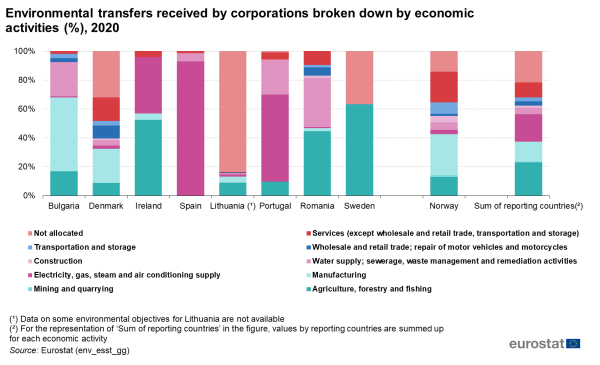
Source: Eurostat (env_esst_ggcp)
Several countries (Sweden, Denmark and Norway) report environmental transfers in the category ‘not elsewhere classified’ (n.e.c.) due to the lack of data sources. This reporting affects the results shown in Figure 5. When excluding amounts of the category ‘not elsewhere classified’ and recalculating the totals and shares, the new results do not modify the main findings (Figure 6). Activities ‘agriculture, forestry and fishing’ and ‘electricity, gas, steam and air conditioning supply’ remain the main receivers of environmental transfers from general government. ‘Manufacturing’ and ‘services (except wholesale and retail trade, transportation and storage)’ increase, on average, their share compared to the scenario including n.e.c.. These four economic activities account for 84 % of environmental transfers paid by general government to corporations, once n.e.c is discounted, or 66 % before discounting n.e.c.(Figure 6).
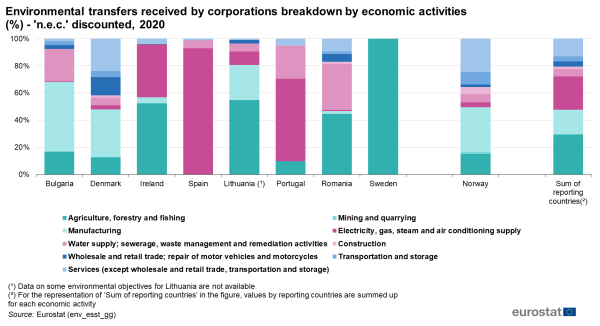
Source: Eurostat (env_esst_ggcp)
Most environmental transfers are mainly about environmental protection
Environmental transfers serve two main environmental objectives: environmental protection and/or management of natural resources (See further explanation in data sources-methodology). In 2020, most environmental transfers concern environmental protection in most of the reporting countries (Figure 7). More than half of the environmental transfers concern environmental protection in all countries except Spain and Denmark. Bulgaria, Sweden and Romania report the highest share of environmental transfers under environmental protection (92 %, 88 % and 84 %, respectively). By contrast, Spain and Denmark report most environmental transfers to management of natural resources (87 % and 66 %, respectively).
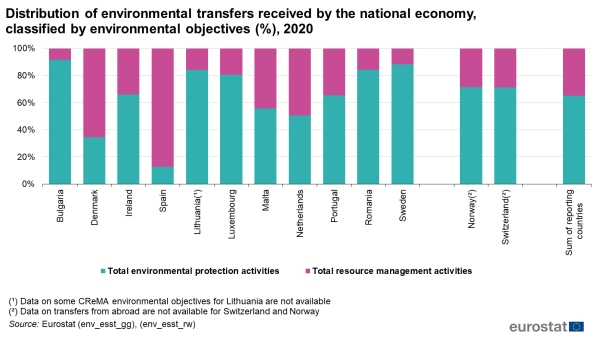
Source: Eurostat (env_esst_gg), (env_esst_rw)
Source data for tables and graphs
Data sources
With environmental transfers, governments finance either measures to reduce the market price of certain products (‘subsidy on product’) or other types of measures to support economic activity or consumption (‘current transfer’) or finance environmental investments (‘capital transfer’). Eurostat collects data on ‘environmental subsidies and similar transfers’ accounts (ESST) on a voluntary basis since 2017. ESST is based on Environmental-Economic Accounting 2012 Central Framework (SEEA-CF 2012) and the European System of National and Regional Accounts (SEA 2010) The concept of ‘subsidies and similar transfers’ refers to ‘transfers’ as covered in SEEA-CF 2012 § 4.136: “transactions in which one institutional unit (in this case, the government) provides a good, service or asset to another unit without receiving from the latter any good, service or asset in return as a direct counterpart”. These transfers may be classified depending on certain characteristics in: Subsidies (D.3) – SEA 2010 §4.30; Social contributions and benefits (D.6) – SEA 2010 §4.83; Other current transfers (D.7) – SEA 2010 §4.112-4.140 and Capital transfers (D.9) – SEA 2010 §4.145. Therefore, subsidies in this terminology are one specific type of transfers. Sometimes, term ‘subsidy’ is used as a synonym of ‘transfers’ or ‘subsidies and similar transfers’ (See SEEA-CF 2012 §4.137) Transfers that are part of the scope of ESST are those mentioned above that are “intended to support activities that protect the environment or reduce the use and extraction of natural resources” (SEEA-CF 2012 §4.138). The set of activities that are considered as ‘environmental’, thus included in the scope, are delineated by the classification of environmental protection activities (CEPA) and the classification of resources management activities (CReMA). CEPA is devoted to ‘environmental protection’, which refers to activities and actions which have as their main purpose the prevention, reduction and elimination of pollution and of any other degradation of the environment. CReMA is devoted to ‘resource management’, which refers to the preservation, maintenance and enhancement of the stock of natural resources and therefore the safeguarding of those resources against depletion (See SEEA-CF 2012§4.12-4.13). Environmental subsidies and similar transfers are paid by general government (S.13 as in SEA 2010 §2.111) and the rest of the world (S.2 as in SEA 2010 §2.131). Those transfers are received by institutional sectors within the economy (general government; corporations – S.11 and 12 in SEA 2010 §2.45 and 2.55; households – S.14 in SEA 2010 §2.118; and non-profit institutions serving households – S.15 in SEA 2010 §2.129) and granted to the rest of the world. In order to ease comprehension by the reader, rest of the world is also named ‘Other countries’ when referring to transfers received from abroad and ‘sent to other countries’ when referring to transfers paid to them by general government. Environmental subsidies and similar transfers paid by general government to corporations are further broken down according to activities using the NACE Rev 2 classification.
Context
The environmental subsidies and similar transfers accounts is part of the European environmental economic accounts framework. Regulation 691/2011, article 4 (pilot studies) and article 10 (report and review) refers to environmental subsidies as a candidate for a new mandatory account. The European Commission proposed in 2022 to include the environmental subsidies in regular reporting on environmental economic accounts for all EU countries (COM(2022) 329 final).
Direct access to
Database
- Environment (env), see:
- Environmental subsidies and similar transfers (env_esst)
- Environmental subsidies and similar transfers from general government, by environmental activity, sector of recipient and ESA category of transfer (ENV_ESST_GG)
- Environmental subsidies and similar transfers from general government to corporations, by environmental activity, ESA category of transfer and NACE Rev. 2 activity of recipient (ENV_ESST_GGCP)
- Environmental subsidies and similar transfers from the Rest of the World to the domestic economy, by environmental activity and ESA category of transfer (ENV_ESST_RW)
Methodology
- Environmental subsidies and similar transfers - Guidelines, 2015 edition
- Environmental subsidies and similar transfers (ESMS metadata file — env_esst_esms)
Legislation
- Regulation (EU) No 691/2011 on European environmental economic accounts
- Summaries of EU legislation: European environmental economic accounts
- Commission Final 0329/2022